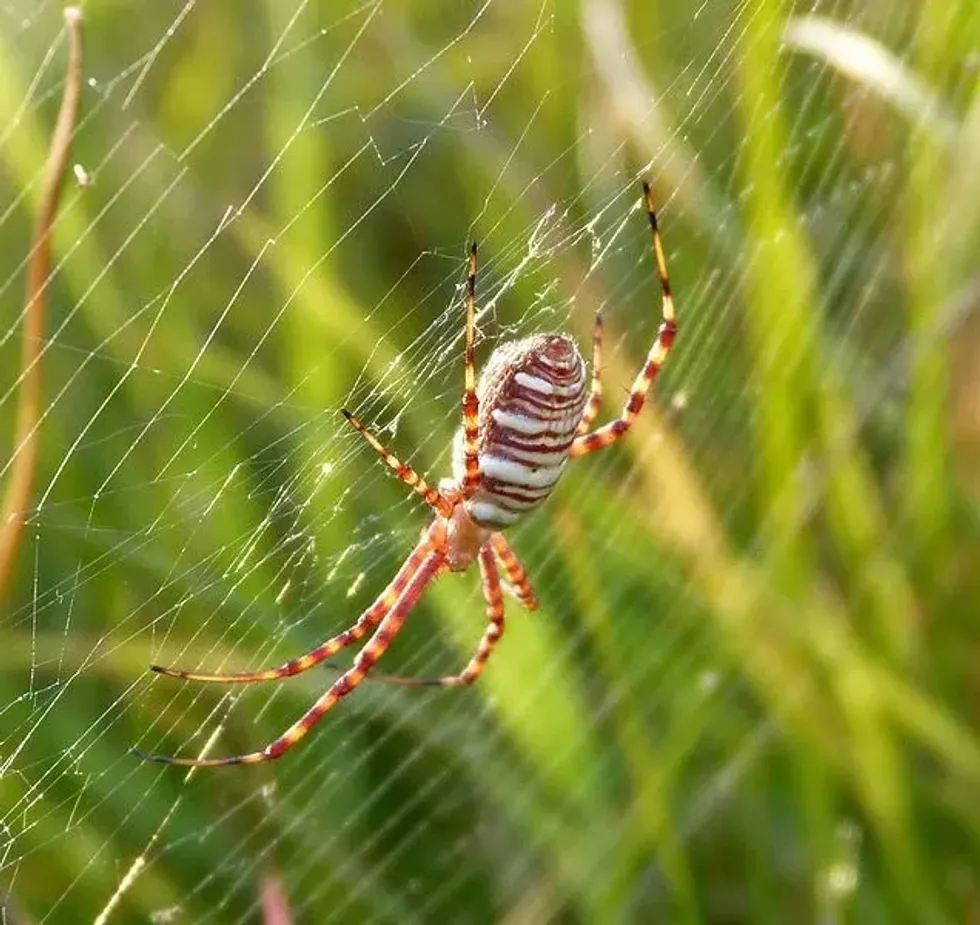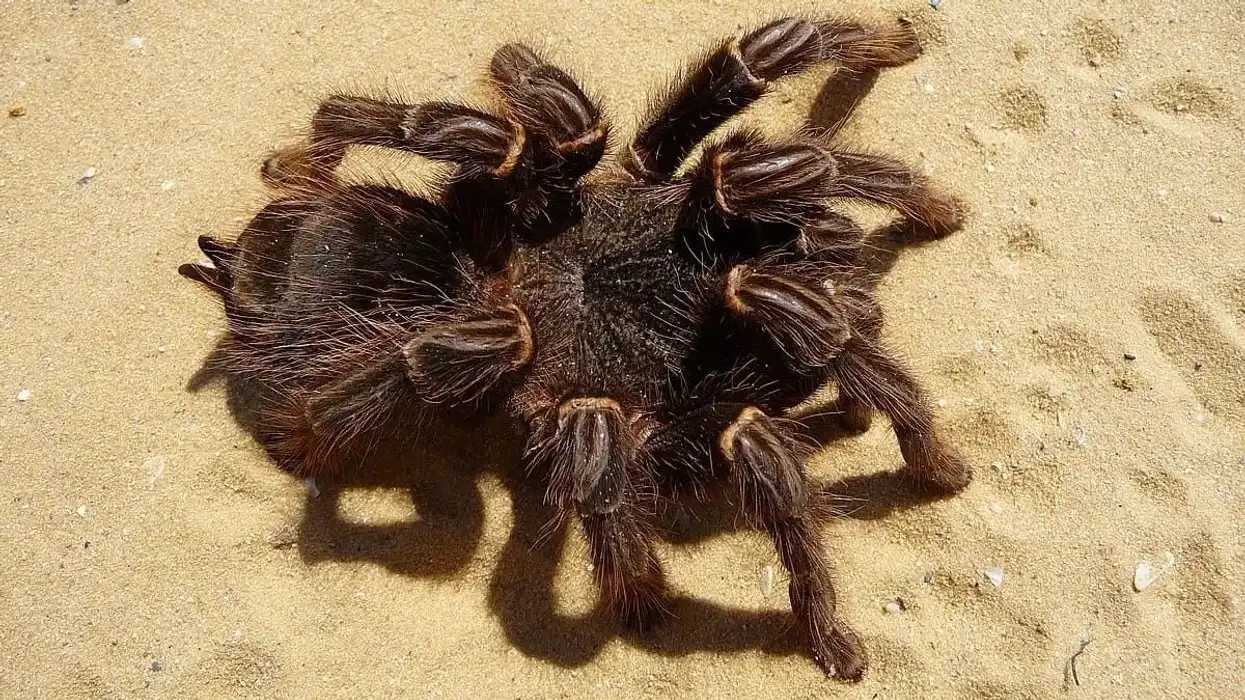Known for its bright yellow color and long, spindly legs the banded garden spider is found in most gardens across the globe. The spider was originally native to only South and North America.
But today, it is found pretty much everywhere. The garden spider, Argiope trifasciata, is very similar to the Argiope bruennichi, which is another orb-weaving spider found in parts of Europe and Asia. They also share some similarities with the yellow garden spider.
Their webs are mainly found in tall grasslands and prairie areas. The banded garden spider weaves its web in a special spiral pattern along with a special decoration at the center of the web.
The spiral shape is what led to this species of spider being known as orb-weaving spiders. This decoration emanating from the center of the web is made from thicker silk and is known as the stabilimentum.
Like many other spiders, they wait for prey to get caught in their web. Once caught, they wrap it in silk and inject venom into the prey's body.
Both the banded and yellow garden spider may also wrap the entire prey's body in silk to consume later. Read on to know more fun facts about the banded garden spider.
If you like garden spiders, check out the Carolina wolf spider and the sac spider.
Banded Garden Spider Interesting Facts
What type of animal is a Banded Garden Spider?
The banded garden spider (Argiope trifasciata) is a type of spider belonging to the genus Argiope.
What class of animal does a Banded Garden Spider belong to?
This garden spider belongs to the class of Arachnida which includes various other arthropods like ticks, scorpions, and mites.
How many Banded Garden Spiders are there in the world?
There is no estimate for the total number of banded garden spiders across the world.
Where does a Banded Garden Spider live?
This garden spider is now a common fixture across the world, though they are mostly seen in the United States as compared to other parts of the world.
What is a Banded Garden Spider's habitat?
The banded garden spider is found in most states of South and North America where it lurks in the tall grass of gardens. They are also found in prairies. Their orb webs are generally suspended from the top of the grass.
Who do Banded Garden Spiders live with?
A typical garden spider will lead a solitary life. They are generally aggressive towards other spiders, except for mating season. Sometimes a few different species (like the banded and the yellow garden spider) have been found to make webs closely together.
How long does a Banded Garden Spider live?
The garden spiders have a life span of one year. Males die after mating. Females may remain alive for longer if they do not freeze to death in the coming winter.
How do they reproduce?
The reproduction of garden spiders is an interesting subject. Males are much smaller in size than females.
Mating season begins after the females have completed molting which is in late summer. These spiders can only mate once - due to a feature known as plugging. The male dies leaving his body plugged into the female.
Once the breeding season is here, the males creep around into the female's webs. Molting leaves the jaws of the females softer, hence this is the most opportune time for males to approach their webs without being eaten. Once plugged, the female lays the eggs, which are many in number since these spiders can only mate once.
The female lays one to three egg sacs with each containing around 300-1400 eggs. The egg sac is shaped like an onion with a brownish color.
What is their conservation status?
The current conservation status of this species is not listed by the International Union for Conservation of Nature. Humans also often kill these spiders, wrongly considering them to be pests.
Banded Garden Spider Fun Facts
What do Banded Garden Spiders look like?

The banded spider has an ovoidal abdomen with a small head. Their abdomen has alternating yellow, black and white bands running in horizontal ridges across it. Their legs also have alternating yellow and black stripes. On the front, they have two long yellow-colored fangs and six eyes on their head.
Garden spiders are quite small in size and will likely cover the length of half a finger. The carapace portion is covered in fine, silvery hairs. One is likely to find them within their silk web.
How cute are they?
For those who like spiders, garden spiders are an extremely cute and harmless variety of spiders. Their bright yellow color makes them quite desirable and pleasing to the eye. Some species are also more predominantly yellow and have very little black on their bodies, and look quite cute in comparison to other species.
How do they communicate?
Garden spiders generally communicate via vibrations. These vibrations are a form of seismic communication. These vibrations can indicate courting, rivalry, or serve to attract insects into their web.
They can mimic the vibration frequency of various insects to lure them into their orb net. Despite having four pairs of eyes, garden spiders can hardly rely on them due to their poor eyesight. They can also jump to indicate territory or danger.
How big is a Banded Garden Spider?
The females are only 0.6-1 in (15-25 mm) long, while the males are only 0.2 in (5.1 mm) long. They are the same size as that of a large black cricket or half the size of a Picasso moth.
How fast can Banded Garden Spiders move?
Orb-weaver spiders are among the slowest spiders in the world. Unlike wolf or fishing spiders, they are mostly static. On average, spiders can move at a speed of 1 mph (1.9 kph). They move via hydrostatic pressure in their legs, which uses their body fluids pumped by their heart to expand their legs.
How much does a Banded Garden Spider weigh?
There is no data regarding the average weight of these spiders.
What are their male and female names of the species?
There is no special name for the male and female of the species. Males and females can be distinguished by their size alone. The male has longer legs (in proportion to body size), though the female is larger.
What would you call a baby Banded Garden Spider?
A baby banded garden spider is called a spiderling.
What do they eat?
Garden spiders generally prey on smaller insects. This includes mosquitoes, flies, aphids, and wasps. The banded and yellow garden spider kill their prey with venom from a bite and wraps them in silk. They do not hunt, rather, they simply wait for prey to walk into their web.
Are they harmful?
Both the banded and yellow garden spiders are not harmful to humans. They generally take care of garden pests and are welcome in gardens to keep pests at bay. They are also unlikely to attack humans. A banded garden spider's poisonous bite will only be mildly painful and can cause a minimum amount of swelling.
Would they make a good pet?
Yes, they are non-aggressive pets when left alone. Garden spiders are inexpensive pets and require little care. Spiders do not eat often, rather they consume large meals once or twice a week.
One cannot expect interaction from them. When kept within a terrarium a garden spider will not be able to construct a net. Keeping a female spider warm can also extend her life as most spiders die in the winter due to the cold.
Did you know...
The webs of spiders are complex things. These webs are made from a mixture of sticky and non-sticky silk. Different species construct webs with different patterns on them.
The banded garden spider relies on spiral webs. The radial lines and spiral lines are alternately sticky and non-sticky. Thus, the yellow-banded garden spider does not get caught in their own web as they only place its feet on the non-sticky parts.
Banded Garden Spider Bites
The banded garden spider bite is poisonous enough to kill their prey. However, on humans, it is similar to getting stung by a wasp and is unlikely to cause any health problems or be fatal for humans. Moreover, these garden spiders are unlikely to bite a human unless one directly threatens their egg sacs.
Benefits Of Banded Garden Spiders
Garden spiders of the order Araneae are beneficial for gardens as they keep them clean of pests. Thus, if one sees a garden spider in the wild, it is best to leave them alone rather than kill them. They begin work in spring and eat insects at the rate of one per day.
Insects can harm plants in a garden due to the transfer of bacteria and fungi. Thus, by removing these pests, the garden spiders from the family Araneidae improve the health of plants!
Here at Kidadl, we have carefully created lots of interesting family-friendly animal facts for everyone to discover! Learn more about some other arthropods including the six-eyed sand spider and the cat-faced spider.
You can even occupy yourself at home by drawing one of our scary spider coloring pages.










